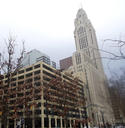I recently got a detailed email from a friend in the Pacific Northwest outlining a possible venture she and her husband are considering. I was one of several people they asked to review the proposal. read more »
Demographics
Two Gen Xers Walk Into A Retirement Home…
- Login to post comments
Latest Data Shows Pre-Pandemic Suburban/Exurban Population Gains
The latest complete American Community Survey (ACS) data, analyzed by the Demographia City Sector Model, indicates that population growth in the nation’s 53 major metropolitan areas (over 1,000,000 residents) continues to be, even before the pandemic, overwhelmingly suburban and exurban. read more »
- Login to post comments
Flight of the Icons
It’s hard to say the word “innovation” and not think of California. Technology has paced the state’s growth in everything from agriculture and oil to housing, entertainment, and aerospace. California has always been the harbinger of the American future, the promise of ever-greater economic and social progress. read more »
- Login to post comments
NIMBYs Are Making More Noise Than Wind Turbines
There is increasing concern that electricity generation from fossil fuels contributes to climate change and air pollution. In response to these concerns, governments around the world are encouraging the installation of intermittent electricity generation projects including Industrial Wind Turbines (IWT’s). read more »
- Login to post comments
Nothing of the Sort
For more than a decade, the idea that Americans are geographically sorting— increasingly choosing to live in neighborhoods populated with people just like themselves—has generated considerable attention in the media and continues to be cited as a very real phenomenon across the nation. read more »
- Login to post comments
The Big Moves: Where People Are Moving
For decades, New York has been the leading exporter of people to other states, though has been severely challenged since 2000 by California. During five years around the housing bust, more net domestic migrants left California than New York. Then, for a time, California’s annual losses were not quite as severe read more »
- Login to post comments
The Big Thing That Trump Got Right and Biden Can’t Afford to Screw Up
For all his ugliness and buffoonery, Donald Trump got some big things right, politically and practically, that Joe Biden will undo at his own peril. Almost all of Trump’s wins, abroad and at home, have one thing in common: They focused on most Americans achieving broader prosperity and not only the best-off. read more »
- Login to post comments
Let's Unite to Draw Distressed Coastal Residents
Thousands of people on the coasts are pleading for help getting out of the urban enclaves from which they once looked down their noses at us, out in Flyover Country.
How should we respond? By taking advantage of an economic-development opportunity for the ages. read more »
- Login to post comments
Toxic Class Encounters
It’s thirty years this autumn since I began my undergraduate degree at Durham University in the North East of England. To tell you the truth I didn’t know much about the city before I applied there. My visit for the three required interviews was very enjoyable, and more positive than some of the less elite institutions I had applied to. I enjoyed looking about the Norman castle and cathedral set high on a hill surrounded by the moat-like River Wear. read more »
- Login to post comments
Why Trump's America Will Live On
Like many, if not most Americans, I am somewhat relieved to see the petulant, nasty and sometimes clearly unhinged Donald Trump leave the White House. Yet for all his antics and vitriol, Trump has left a legacy that will be difficult to ignore and, given the dispensation of his opponents, could shape the future for the next decade. read more »
- Login to post comments






















